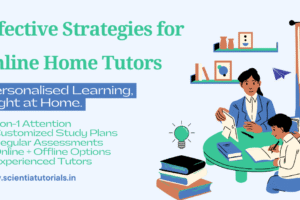Building Bridges: Essential Communication Skills for Home Tutors
Introduction
Effective communication is the cornerstone of successful home tutoring. As home tutors, establishing strong communication skills with students is vital for fostering an environment conducive to learning. Unlike traditional classrooms, home tutoring allows for more personalized interactions, making the ability to communicate effectively even more crucial. Good communication not only aids in delivering academic content but also helps build trust, encourages student engagement, and enhances overall learning outcomes.
In this article, we will explore essential tips for home tutors on building strong communication skills. We will delve into various aspects, including verbal and non-verbal communication, active listening, feedback mechanisms, and the importance of creating a supportive dialogue. Let’s embark on this journey to enhance the tutor-student relationship through effective communication.
Understanding the Importance of Communication in Tutoring
Effective communication in home tutoring is important for several reasons:
- Enhances Understanding: Clear explanations and instructions help students grasp complex concepts better.
- Builds Trust: Open and honest communication fosters a safe environment where students feel comfortable expressing their thoughts and concerns.
- Encourages Engagement: When tutors communicate effectively, they can engage students in discussions, encouraging participation and motivation.
- Facilitates Feedback: Strong communication allows for constructive feedback, enabling students to improve and grow academically.
Now, let’s explore some essential strategies for home tutors to build strong communication skills.
1. Establish Clear Expectations
Set the Tone Early
At the start of your tutoring relationship, it’s essential to set clear expectations regarding communication. Discuss the following aspects:
- Goals and Objectives: Clearly outline the academic goals for the tutoring sessions. What subjects or topics will be covered? What are the expected outcomes?
- Communication Style: Share your preferred communication methods—whether through face-to-face discussions, emails, or messaging apps—and encourage students to express their preferences as well.
- Availability: Specify your availability for questions outside of tutoring sessions. Will you be accessible for additional help via text or email?
By establishing these expectations early, you create a structured framework that fosters effective communication.
2. Use Clear and Concise Language
Simplify Complex Concepts
When explaining subjects, it’s vital to use clear and concise language. Here are some tips to ensure your explanations are easy to understand:
- Avoid Jargon: While some technical terms are necessary, minimize jargon and use everyday language where possible.
- Break Down Information: Divide complex concepts into smaller, manageable parts. This step-by-step approach can help students grasp the material better.
- Provide Examples: Use relevant examples and analogies to illustrate difficult ideas, making them more relatable and easier to comprehend.
3. Develop Active Listening Skills
Prioritize Listening
Effective communication is not just about speaking clearly; it’s also about listening actively. Here’s how to develop your active listening skills:
- Maintain Eye Contact: Show that you are engaged and interested in what the student is saying. Maintaining eye contact can enhance the connection between you and the student.
- Avoid Interrupting: Let students express their thoughts fully before responding. Interrupting can hinder their ability to articulate their ideas.
- Reflect and Summarize: After a student shares their thoughts, reflect back what you’ve heard and summarize their points. This practice shows that you value their input and helps clarify any misunderstandings.
4. Encourage Open Dialogue
Create a Safe Space for Expression
Fostering an environment of open dialogue is essential for effective communication. Here are some ways to encourage students to express themselves freely:
- Ask Open-Ended Questions: Instead of yes/no questions, ask open-ended questions that require more thoughtful responses. For example, instead of asking, “Did you understand this concept?” ask, “What part of this concept do you find challenging?”
- Validate Feelings and Opinions: Acknowledge students’ feelings and opinions, even if they differ from yours. This validation encourages students to share their thoughts without fear of judgment.
- Use Positive Reinforcement: When students express themselves, use positive reinforcement to encourage further communication. Praise their effort and engagement, which helps build their confidence.
5. Provide Constructive Feedback
Emphasize Growth and Improvement
Feedback is an integral part of the learning process, and providing constructive feedback can significantly enhance communication. Here’s how to do it effectively:
- Be Specific: Instead of saying, “Good job,” provide specific feedback, such as, “Your analysis of the text was insightful; I particularly liked how you connected the main idea to the theme.”
- Focus on the Process: Emphasize the effort and strategies the student used rather than just the final outcome. For example, “I appreciate the method you used to solve this problem; it shows your understanding of the concepts.”
- Encourage Self-Assessment: Invite students to assess their performance. Ask questions like, “What do you think you did well, and what would you like to improve on?” This approach promotes self-reflection and personal growth.
6. Utilize Non-Verbal Communication
Pay Attention to Body Language
Non-verbal communication plays a significant role in how messages are conveyed and received. Here are ways to enhance non-verbal communication:
- Be Aware of Your Body Language: Your posture, facial expressions, and gestures can communicate confidence, openness, and enthusiasm. Be conscious of your body language and ensure it aligns with your verbal messages.
- Observe Students’ Non-Verbal Cues: Pay attention to students’ body language, such as fidgeting or lack of eye contact. These cues can indicate confusion or discomfort, prompting you to adjust your approach.
- Encourage Positive Non-Verbal Feedback: Use nods, smiles, and encouraging gestures to show students that you are engaged and supportive during their explanations.
7. Adapt to Different Learning Styles
Recognize Individual Needs
Every student has a unique learning style, and adapting your communication approach to fit these styles is essential. Here’s how to recognize and respond to different learning preferences:
- Visual Learners: Use diagrams, charts, and visual aids to enhance understanding. Encourage students to visualize concepts through drawings or graphic organizers.
- Auditory Learners: Engage auditory learners through discussions, storytelling, or reading aloud. Encourage them to verbalize their thoughts and ideas during sessions.
- Kinesthetic Learners: Incorporate hands-on activities and physical engagement in your lessons. Encourage movement or use tangible objects to illustrate concepts.
8. Foster a Growth Mindset
Encourage Perseverance
Promoting a growth mindset can significantly influence how students respond to challenges and failures. Here’s how to foster this mindset through communication:
- Normalize Mistakes: Communicate that mistakes are a natural part of the learning process. Share examples of famous individuals who faced challenges but ultimately succeeded through perseverance.
- Encourage Questions: Promote a culture of curiosity where students feel comfortable asking questions. Remind them that questioning is a vital part of learning.
- Highlight Effort Over Ability: Praise students for their hard work and effort rather than solely focusing on their intelligence. This focus can help them view challenges as opportunities for growth.
9. Use Technology to Enhance Communication
Leverage Digital Tools
In the digital age, technology can significantly enhance communication between tutors and students. Consider the following tools and platforms:
- Communication Apps: Use messaging platforms like WhatsApp or Slack for quick communication, reminders, and feedback.
- Video Conferencing Tools: If tutoring online, use platforms like Zoom or Google Meet to facilitate live discussions and interactions.
- Educational Platforms: Leverage online resources and educational tools to share materials, track progress, and provide additional support outside of tutoring sessions.
10. Reflect on Communication Practices
Continuous Improvement
Effective communication is an ongoing process. Regularly reflect on your communication practices to identify areas for improvement. Here’s how:
- Seek Feedback: Encourage students to provide feedback on your communication style. Ask questions like, “How can I communicate better to support your learning?”
- Self-Assessment: After each session, take a moment to reflect on your communication effectiveness. Consider what went well and what could be improved.
- Stay Updated: Stay informed about new communication strategies and educational tools. Engage in professional development to enhance your skills continually.
Conclusion
Building strong communication skills is vital for home tutors seeking to create a positive and productive learning environment. By establishing clear expectations, using concise language, developing active listening skills, and fostering open dialogue, tutors can enhance their interactions with students. Providing constructive feedback, utilizing non-verbal communication, and adapting to individual learning styles further strengthen these relationships.
Ultimately, effective communication fosters trust, engagement, and growth, empowering students to thrive academically and personally. As home tutors, continuously reflecting on and improving communication practices can lead to better learning outcomes and a fulfilling tutoring experience for both tutors and students. By mastering the art of communication, tutors can build bridges that support student success and inspire a love for learning.



